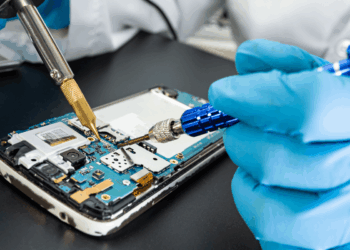Repair shops and advocates convened during the first day of the Electronics Sustainability Summit this week to share tips on improving repair businesses, the evolution of OEM and repair community relationships and the repair legislative landscape.
Hosted by Sustainable Electronics Recycling International, the Electronics Sustainability Summit was held Oct. 22-24 in Austin, Texas. Mobile Repair Day kicked the event off on Oct. 22, organized by SERI’s Repair Steering Committee.
Although the wider conference was focused on all electronics, iFixit CEO Kyle Wiens, who emceed the Mobile Repair Day, said the mobile-specific programming served a key goal.
“The leading edge of the repair world is the repair and refurbishment of smartphones,” he told E-Scrap News during the show. “That’s where the bulk of the money and innovation is. And I think part of my goal is to take the knowledge and innovation that we have in the mobile repair space and then expand it into other industries.”
Manufacturer view on repair is ‘evolving and changing’
During a session on the unique challenges faced by independent repair firms, speakers noted how device repairability has evolved in recent years.
All told, the OEM-repair dynamic has changed in the last 5-10 years, said Shay Kripalani, CEO of Georgia-based e-commerce firm Injured Gadgets. He recalled when an iPhone had to be replaced if its home button broke. And it was far more common in the past for OEMs to push out updates and not worry about the repair world. Now, many operating systems have diagnostics built in.
“They see that repair is evolving and changing,” Kripalani said of OEMs. “I can honestly say I really appreciate the changes some of the OEMs have made and the steps they’ve taken to talk to us.”
As the OEM-repair relationship evolves, repair shops are also looking at expanding the type of devices they handle. But speakers described how it takes a certain critical mass of devices needing repair – and consumers having the idea to repair rather than replace – before it makes sense. Consumer drones, for example, aren’t coming in in a big way just yet.
But game console parts? “If you guys aren’t into that, it’s insane,” Kripalani told the audience.
“Game console parts are a massive money-maker,” Kripalani said, adding a few businesses have a “complete monopoly on it because they are the only ones offering it.”
Adam Wolf, president of the National Wireless Independent Dealer Association, noted an HDMI port on a gaming console can run $3 or $4, and one attendee said from the audience that he can charge $300 per job replacing those parts.
Repair shops would also be wise to keep key parts like the HDMI port stocked at all times, because customer convenience is key to repair shop success. If somebody is coming into a repair shop, that’s because they want the service done now – that’s why they’re not going onto Amazon Prime, which has conditioned people to know they can get something the next day, Wolf said.
And Chad Johansen of New Hampshire-based NH iPhone Repair added that convenience can allow for a premium to be charged as well, because customers are often willing to pay more for immediacy.
How data security plays into the repair shop environment
Data security plays into the ITAD process in obvious ways, with the need to protect businesses’ sensitive information during the asset retirement and redeployment process. Some of those translate over to consumer-facing repair shops, but there are also unique needs.
For instance, one basic security question is how to validate that the person getting a phone serviced is the person who owns the device. That’s particularly important when it’s a customer who is coming in to get data recovered off a locked or broken device.
It can be a sensitive issue that raises ethical questions, with possibilities like vindictive exes wanting info on a former partner’s discarded phone or family members of a deceased person wanting to access their Bitcoin wallet.
Mike Cobb, chief information security officer at Novato, California-based DriveSavers, said his company deals with this almost daily now, and DriveSavers’ standard practice is to send the customer a DocuSign form, where they sign a statement guaranteeing that this is their property. The company can cross-reference that with the name on the phone, which can be somewhat informal verification.
“It’s becoming apparent we need to take more steps on that, but it’s difficult,” Cobb said, especially because his company gets more than 60,000 calls per year from customers wanting data recovery. Docusign is something his company is “more and more going to do in any type of data recovery.” And adding that step may send a message to bad actors not to work with his shop, he said.
It’s worth it to add protocols like that, because one lapse in security protocol “could very well be the end of your business,” said Chris Bross, president of consulting firm TierraByte.
Repair advocates reflect on progress and future
It’s been seven years since the Repair Association and iFixit teamed up with the U.S. Public Interest Research Group to advocate for right-to-repair legislation, which requires manufacturers to provide the same repair resources to independent shops and consumers as they do to their own authorized providers.
During a right-to-repair panel, speakers reflected on how far things have come and where their priorities sit currently.
When they teamed up to launch U.S. PIRG’s repair campaign in fall 2017, it turned out to be prudent timing: Just a few weeks after the launch, what came to be known as “BatteryGate” unfolded. Apple took note of a problem in which devices received insufficient power supply, causing random shutdowns on certain devices. The company infamously responded by throttling device performance, causing major slowdowns in device performance for many iPhone users. The saga ultimately led to multiple legal settlements.
In response to public backlash, the company began offering discounted battery replacements for $29. The customer response was massive, and months-long waitlists began popping up to get the service. At one point, the Repair Association estimated that if Apple’s Authorized Service Providers – the select repair firms that were allowed to do official repairs on Apple phones without voiding the warranty – were to do nothing but battery replacements all day long during that time, it would take several years to work through the backlog.
It’s a fitting time to look back, said Liz Chamberlain, director of sustainability at iFixit, because Apple has recently rolled out some significant changes to its battery design. The iPhone 16, notably, uses a battery adhesive that is electrically removable, and the device features a redesigned case for easy opening.
Additionally, the latest Apple iOS 18.01 update will reportedly remove a well-known warning that pops up when third-party battery replacements are performed, and it will reportedly bring back the battery health feature even when a third-party battery has been used.
“Thinking back on BatteryGate, we really are in a more repairable world,” Chamberlain said.
But with that progress, the need for improvement is ever clearer. Activation locks – billed as an anti-theft measure to lock a phone preventing unauthorized use – continue to thwart repair efforts.
Paul Roberts, president of Secure Resilient Future Foundation, said that while these provide important anti-theft measures, they are complicating the reuse of completely functional hardware. He suggested that more than 90% of activation-locked phones are not locked because of any nefarious activity but rather because a user bought a new device and forgot to reset their old one.
Justin Carroll, founder and CEO of repair shop Fruit Fixed, suggested Apple and other OEMs could implement a tool that reminds people on their Apple ID account that they haven’t unlocked a device for a certain amount of time, then asks if they want to remove the activation lock.
Repair advocates are also focused on simply passing more right-to-repair bills. Legislatures in Oregon and Colorado passed consumer electronics right-to-repair laws this year, following California, New York and Minnesota in previous legislative sessions. That’s a huge step, but the state-by-state approach leaves obvious gaps in repair access.
As one example, Nathan Proctor, senior right to repair campaign director for U.S. PIRG, described Colorado’s e-mobility repair law that was expanded to cover consumer electronics this year. Among other points, it requires manufacturers of wheelchairs to make repair resources available to wheelchair owners. But Proctor noted some manufacturers are providing those resources only within Colorado, and that’s all the law can require – a motivation for passing such bills in more states.
Advocates are also pushing for greater enforcement of the existing four right-to-repair laws. Enforcement largely comes down to attorneys general in those states, Chamberlain said. Repair advocates are collecting substantiated reports of lack of compliance and forwarding those reports to the relevant attorneys general, Chamberlain added. Complaints can be submitted at repair.org/repair-complaints.


























